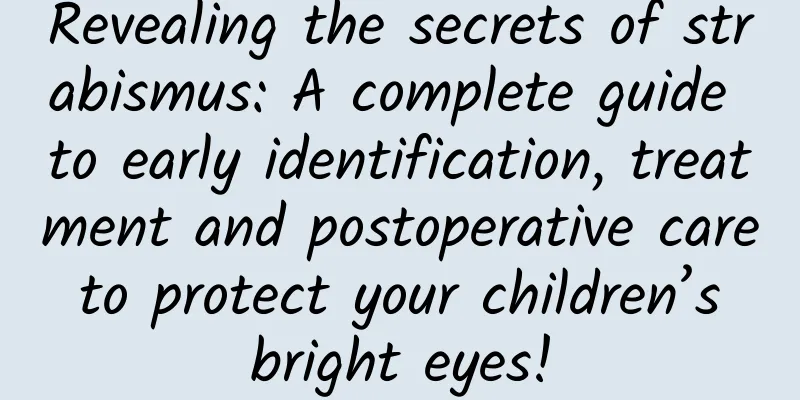Revealing the secrets of strabismus: A complete guide to early identification, treatment and postoperative care to protect your children’s bright eyes!

|
Every child is a treasure of the family, bringing us endless joy and hope. However, some newborns may face the problem of "strabismus", that is, the eye position deviates from the normal state. For many new mothers, they may ignore this phenomenon, or have a fluke mentality, thinking that the strabismus problem will naturally improve when the child grows up. But in fact, strabismus not only affects the child's appearance, but may also have a profound impact on the child's physical development. Specifically, strabismus may cause skeletal malformations, such as crooked head and neck or scoliosis. At the same time, strabismus will also affect the development of the child's binocular vision function, which may cause problems such as poor vision, impaired stereoscopic vision and amblyopia, which will affect the child's future career choices and participation in social activities. 1. What is strabismus? Eye movement is controlled by six extraocular muscles. Under normal circumstances, these muscles help both eyes look in the same direction and at the same object at the same time. Once the strength of the extraocular muscles is unbalanced, strabismus will occur. Strabismus refers to a disease in which one eye fixes on a target while the other eye deviates from it. It is commonly known as "squint eyes" and is the most common eye muscle disease in children. It can be caused by many factors. If congenital strabismus or acquired strabismus in children is not discovered and treated early, it will often affect the development of children's vision, destroy normal binocular vision, and cause stereoscopic vision dysfunction, thus affecting the children's mental health and future work and life. 2. How to detect strabismus early? These behaviors or tests of your child can help you determine whether your child may have strabismus. (1) I like to close one eye when looking at things in the sun. When the light is strong, the child is found to close one eye, which is a characteristic of intermittent strabismus. (2) Tilting the head to see things If a child often tilts his head to see things, he may have vertical deviation, which is a compensatory head position to avoid visual interference such as double vision. Parents need to take their children to an ophthalmologist if they find this situation! At the same time, they should also go to the surgeon to rule out surgical torticollis! 3. Treatment of strabismus Surgery Most strabismus require surgical treatment. Strabismus surgery is not only to correct eye position and improve appearance, but more importantly to establish binocular vision. Nonsurgical treatment Non-surgical treatments mainly include: wearing glasses, binocular vision training, medication (at the initial onset of acquired paralytic strabismus), etc. If combined with amblyopia, treat amblyopia first and then strabismus. Strabismus correction is a surgical method that has been proven in long-term practice and has mature technology. The surgery is relatively safe and will not leave obvious surgical marks on the patient's appearance, nor will it damage the normal function of the eyeball. Therefore, patients do not need to miss the best time for strabismus treatment due to excessive worry. Of course, the surgery still needs to be performed in a hospital with professional strabismus correction surgery skills and experience. 4. Precautions after strabismus surgery (1) After surgery, there may be threads on the eyes, which may feel like a foreign body. Patients should avoid rubbing their eyes. (2) Follow the doctor’s advice and use antibiotic eye drops or glucocorticoid eye drops to prevent infection. (3) Pay attention to eye hygiene and avoid eye fatigue. (4) You may see double vision after the operation. Don’t be afraid. Generally, it will disappear gradually. (5) Patients with refractive errors before surgery should continue to wear glasses after surgery. Some patients with accommodative esotropia should continue to wear glasses after surgery. (6) Strabismus surgery only corrects the eye position. To establish binocular vision function, binocular vision function training can be performed, which is conducive to the stability of eye position. (7) The eye position may change in the long term after surgery, so patients should undergo regular checkups. Medical knowledge is for reference only and is not used as a basis for diagnosis or treatment! Image source: original design, photo.net, provided by the hospital |
<<: Ouch, my old waist! These exercises are the most harmful to your waist. Have you done them?
Recommend
What is the best breakfast? Can protein powder be eaten for breakfast?
Breakfast is not only necessary, but also nutriti...
What should pregnant women do if they eat barbecue?
The dietary structure of pregnant women should be...
What is better to drink during menstruation?
Dietary health issues during menstruation need sp...
Is it normal to have black color during menstruation?
In our daily life, we often encounter many proble...
How to prevent Corgi from shedding? What can I do if Corgi sheds a lot?
Hair loss is a very common symptom in dogs, espec...
The most accurate signs of having a boy in late pregnancy
Many female friends want to know whether they are...
Can high estrogen levels cause breast tenderness?
Some female friends always feel a certain degree ...
Is it more effective to infuse fluid during menstruation to reduce inflammation?
Infusion therapy is an anti-inflammatory treatmen...
Why do I have armpit pain before my period?
Menstruation is the menstrual phenomenon of women...
Reasons for oral examination during pregnancy
Oral problems are a common disease. Many people h...
If a child has normal IQ but cannot read the words in a book, he may be suffering from "dyslexia"
They have normal vision and normal minds, but the...
Precautions after cord blood puncture
Umbilical cord blood puncture is generally used t...
Can I eat chicken liver during confinement?
It is said that confinement is the time when wome...
Vinegar has 5 special effects on women
Vinegar is not only a necessary condiment in the ...
A woman's fate is determined by deep neck lines
An explanation of the facial features of women wi...









